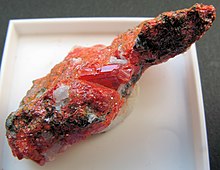 Realgar from the Getchell Mine. Characteristic traces of silver, arsenic, antimony, mercury, thallium and barium are associated with Carlin-type mineralization, and are widely used as pathfinders in geochemical prospecting for gold. Realgar from the Getchell Mine. Characteristic traces of silver, arsenic, antimony, mercury, thallium and barium are associated with Carlin-type mineralization, and are widely used as pathfinders in geochemical prospecting for gold. | |
| Location | |
|---|---|
 | |
| Potosi Mining District | Nevada |
| Country | United States |
| Coordinates | 41°13′19.68″N 117°15′3.48″W / 41.2221333°N 117.2509667°W / 41.2221333; -117.2509667 |

The Getchell Mine is an underground gold mine in the Potosi Mining District of Humboldt County, Nevada, on the east flank of the Osgood Mountains, 35 miles northeast of Winnemucca. Prospectors Edward Knight and Emmet Chase discovered gold in 1933 and located the first claims in 1934. With the financial backing of Noble Getchell and George Wingfield, the Getchell Mine, Inc. was organized in 1936 and the mine was brought into production in 1938.
The mining operation currently consists of two underground mines, Getchell and Turquoise Ridge, operated as the Turquoise Ridge Joint Venture. Barrick Gold is operator and 75% owner with Newmont Mining owning the remaining 25%. The mining methods currently used are cut-and-fill and long hole stoping. The refractory gold ore is treated by pressure oxidation technology at the Twin Creeks Sage autoclave and gold recovered using conventional carbon-in-leach technology.
The gold deposit is a sediment-hosted disseminated Carlin–type deposit, with sub-micron sized gold distributed in pyrite and marcasite.
The mineral getchellite, a rare sulfide of arsenic and antimony, AsSbS3, was discovered at and named after the Getchell mine.
References
- ^ Cline, Jean S.; Hofstra, Albert H.; Muntean, John L.; Tosdal, Richard M.; Hickey, Kenneth A. (2005). "Carlin-Type Gold Deposits in Nevada: Critical Geologic Characteristics and Viable Models". Economic Geology. One Hundredth Anniversary Volume (PDF). Denver, CO: Society of Economic Geologists, Inc. pp. 451–484. ISBN 978-1-887483-01-8. Retrieved 20 July 2014.
- ^ Tingley, Joseph V. (1998). Mining Districts of Nevada (PDF). Vol. Bulletin 47 (2 ed.). Reno, NV: Nevada Bureau of Mines and Geology. p. 177. Archived from the original (PDF) on 21 February 2015. Retrieved 20 July 2014.
- "The Getchell Project" (PDF). FirstMiss Gold, Inc. 1988. Archived from the original (PDF) on 12 August 2014. Retrieved 20 July 2014.
- ^ "Turquoise Ridge (75%)". Barrick Gold Corporation. Archived from the original on 19 July 2014. Retrieved 20 July 2014.
- Guillermo, Tomás A.; Wuensch, B.J. (1973). "The Crystal Structure of Getchellite, AsSbS3" (PDF). Acta Crystallographica. B29 (11): 2536–2541. doi:10.1107/S0567740873006965. Archived from the original (PDF) on 12 August 2014. Retrieved 20 July 2014.
Further reading
- Joralemon, P. (1951). "The occurrence of gold at the Getchell Mine, Nevada". Economic Geology. 46 (3): 267–310. doi:10.2113/gsecongeo.46.3.267.
- Cline, J. S. (2001). "Timing of Gold and Arsenic Sulfide Mineral Deposition at the Getchell Carlin-Type Gold Deposit, North-Central Nevada" (PDF). Economic Geology. 96 (1): 75–89. doi:10.2113/96.1.75. Archived from the original (PDF) on 2011-07-27.
External links
- Getchell Mine at mindat.org
- Turquoise Ridge JV, Twin Creeks Operation, mine data updated to 2018. Accessed 11/9/2019.
- Photo tour of Turquoise Ridge, Mar 21, 2018. Accessed 11/9/2019
- Turquoise Ridge Mine at Western Mining History
| Barrick Gold Corporation | |||||||||
|---|---|---|---|---|---|---|---|---|---|
| Corporate management |
| ||||||||
| Mines |
| ||||||||
41°13′04″N 117°15′17″W / 41.217645°N 117.25479°W / 41.217645; -117.25479
This article about a specific mine is a stub. You can help Misplaced Pages by expanding it. |
This Humboldt County, Nevada state location article is a stub. You can help Misplaced Pages by expanding it. |